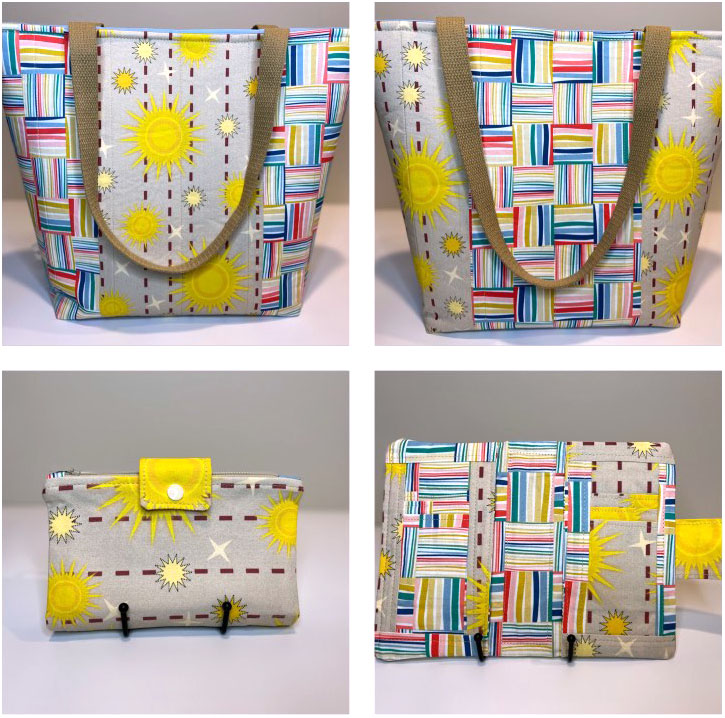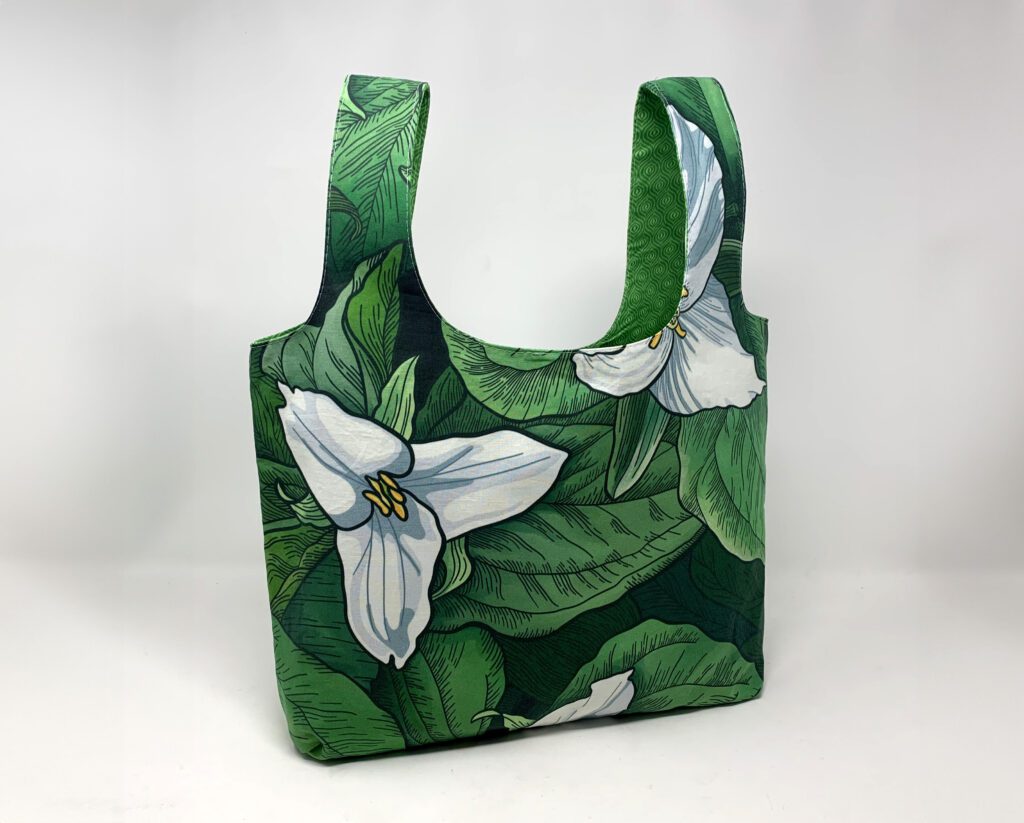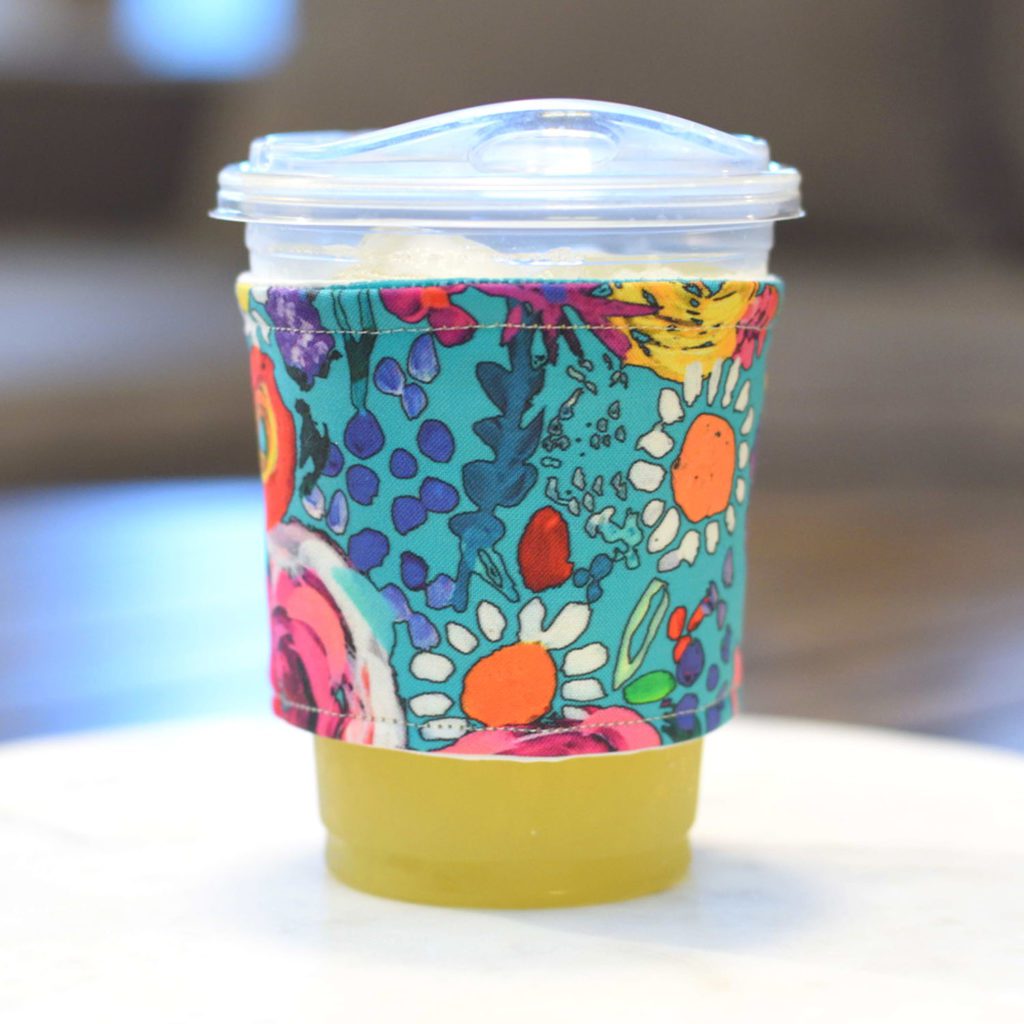Spoonflower Petal Signature Cotton Project Ideas

Spoonflower is a print on demand textile and wallpaper manufacturer. Makers can shop for designs by independent artists from around the world and order the exact amount of fabric that they need. The choice of pattern and color available is staggering. For sewists, this creates a unique opportunity to customize their projects.
In this post, I will share some tips and tricks I learned while sewing with Spoonflower Petal Signature cotton as well as share project ideas from other makers.
Petal Signature Cotton is Spoonflower’s best-selling, every day-use 100% cotton woven fabric and it’s a great place to start if you are new to print on demand textiles. Makers use it for quilting, crafts, bags, costuming and apparel. With vivid, crisp color, it is a great choice for showcasing detailed designs.
Designs are printed on one side of the fabric using eco-friendly, water-based inks. This quilting-weight cotton is color fast, and machine washable. (*tip: to avoid fraying, stay stitch 1/4″ from the cut edge before pre-washing fabric) Petal Signature Cotton is sturdier than a batik weight cotton, suitable for projects that require more structure than drape.
Home sewists can use domestic machines, sergers or longarm machines to work with Petal Signature Cotton. It is suitable for hand-embroidery but, for hand-stitching through layered quilts, I would recommend choosing Spoonflower Cotton Poplin instead.
Bags, Purses and Zips
Bags, purses, and zippered pouches are excellent projects for sewing with Petal Signature Cotton. This fabric resists fraying and holds its shape well, making it ideal for patterns with curves or small pieces. Its weight provides a decent amount of structure, making it suitable for bag exteriors when paired with the right interfacing and stabilizers. For projects requiring extra durability, such as bags and wallets, it can be ironed at a cotton heat setting, so reinforcing the fabric with a woven fusible interfacing like SF101 works beautifully.
I especially love using bags to showcase the stunning artwork available on Spoonflower. Their shapes provide a fantastic canvas for playing with color and graphics, turning functional accessories into wearable pieces of art.
The Nasyow Pouch

This Nasyow Pouch is a free, beginner-friendly sewing pattern by Country Cow Designs. This project is sewn with 1 fat quarter of my Halo Floral Nyon design on Petal Signature Cotton. I fused a layer of medium weight woven interfacing to the exterior pattern pieces before sewing, but for a crisper finish you can use a non-woven interfacing. I used a single layer of Petal Signature Cotton remnants for the lining and zipper tabs. The hidden interior seams on this zipper pouch are finished with a zigzag stitch, and the topstitching can be done with a standard presser foot, or a zipper foot.
The Kaede Hip Bag


Exploring the Kaede Hip Bag: My First and Second Takes
The Kaede Hip Bag quickly became one of my favorite sewing projects. This versatile pattern offers so much room for customization and creativity, and I was thrilled to try it out with my own fabric designs.
First Attempt: Godavari Floral Paisley
For my first Kaede Hip Bag, I chose my Godavari Floral Paisley design for the exterior. It required less than one fat quarter of fabric, making it a fantastic project for using up smaller cuts. For the lining, I opted to use quilting remnants I had on hand.
One of the things I loved most about this project was the intriguing assembly process. The pattern’s construction kept me engaged and taught me a few new sewing techniques along the way. I also appreciated the bag’s versatility; it can be worn as a hip bag or a crossbody, depending on your preference.
My trusty Pfaff 260 sewing machine handled the layers beautifully throughout the project. I only needed to switch to a denim needle during the final assembly. Sewn in Petal Signature Cotton this hip bag is domestic machine friendly.

Second Attempt: Darling Diamonds with a Structural Upgrade
I enjoyed sewing the Kaede Hip Bag so much that I immediately started on two more. This time, I used my Darling Diamonds design for the exterior.
To soften the side worn next to the body, I added a piece of fusible foam to the back panel. This made the bag more comfortable for an active kiddo to wear all weekend at a music festival!
Why I’ll Keep Sewing the Kaede Hip Bag
This bag’s clever design and versatility have earned it a permanent place in my sewing studio. I can already imagine making more versions in a variety of colors and styles. There are so many occasions where a stylish, hands-free bag is a welcome accessory. For me, it’s dog walking and music festivals.
The Celestial Curve Shoulder Bag

For this Celestial Curve Shoulder Bag by Chris W Designs, I used less than half a yard of my Carnations Arts and Crafts Trailing Floral, Stillwater design, paired with a sturdy polyester fabric for the strap, accent, and lining. When constructing bag exteriors, I often treat myself to using a double layer of SF101 interfacing for added structure and longevity. This particular pattern thoughtfully includes separate pieces for the second layer of interfacing, allowing you to reinforce key areas while keeping excess bulk out of the seams for a polished finish.
The entire project was sewn on my vintage Pfaff 360, a workhorse that continues to prove its reliability and tenacity after decades of use. This bag is an excellent project for both beginners and experienced sewists, and is supported by a step-by-step tutorial video. It requires minimal notions and no hardware. Its simplicity makes it an ideal choice for using up scraps or repurposing materials you already have on hand.
Here’s a handy tip I learned from my costuming experience: if you don’t have rigilene boning on hand, you can substitute it with industrial-strength zip ties. They’re an affordable and accessible alternative that works wonderfully for adding structure. To prepare them, simply trim the points into rounded edges and lightly sand the cut areas to avoid snags.
Overall, this bag is not only functional but also a joy to create, offering plenty of opportunities to personalize with fabrics and finishes to suit your style. Whether you’re crafting for yourself or as a thoughtful gift, this project is a satisfying weekend sewing endeavor.
The Sunshine Crossbody
The Sunshine Crossbody is a free beginner-friendly pattern from Bagstock Designs. Jess at OklaRoots has video tutorials for a couple of different variations of this pattern.

MeMaw Made it Creations used one fat quarter of my Floral Toile design coordinated with one fat quarter of Cinnamon Essex yarn-dyed linen for the exterior of this petite crossbody. Judi often lines her bags with waterproof canvas because it is sturdy and easy to clean. She recommends to always pre-wash your cotton fabrics before sewing.
‘For projects that need more structure, I’ve found that the darker colors make the petal cotton very sturdy, compared to lighter designs.’ Judi Niermann
The Teloujay 3.0 Crossbody Bag

Judi Niermann of MeMaw Made it Creations paired Petal Cotton with charcoal cork, water resistant canvas and batik for this Teloujay. She recommends interfacing the cotton with an sf101 or equivalent. The design is Just Jellies by Kate Rhees.
‘I love this crossbody! Clever design with a wraparound slip pocket and open wide zipper.’ – Judi

TOTES
Cyndi Funkhouser of Belle Originals stitched this Sunshine and Rainbows Tote and coordinating wallet with Scrapbook Suns by Anzela Simcock. Petal Signature Cotton is a great choice for makers who love to play with color and bold patterns.









Apparel
If you are using Petal Signature to sew apparel, choose patterns that have some ease to the fit. This woven fabric has some give, but no stretch.
Wrap Dress

A wrap dress is a great choice for woven fabrics. Here I used two yards of my Trillium in the Woods design to sew a summer dress. This vintage 1950s McCall’s 1921 pattern has two ties that button at the back and is easy to adjust for fit. I cut the selvage off the printed yardage of cotton and used it to make my own bias tape for the binding. Petal Signature Cotton is sturdy and opaque enough to not require any lining.
** McCall’s later made an adult version of this pattern McCall’s 1948
Button Up Shirt

I made this button up blouse from 2 yards of my Halo Floral Bloodstone design. The Today’s Fit V7903 pattern offers suggestions for when to stop and check the fit of your garment so that you can make adjustments as you’re sewing. Petal Signature Cotton, with its stability and structure, is a good choice for shirts with this type of collar band and turned back cuff detailing.
Quilts and Quilted Projects
I cannot write about quilting with Spoonflower fabrics without mentioning cheater quilts. A cheater quilt is a panel of fabric with printed squares of different designs. You can design your own quilt top by creating a collection on Spoonflower, and then dragging and dropping the designs into a user-friendly template. Here is how to get started: Spoonflower Fill-A-Yard

Brittany Lane Allen designed and sewed this quilt using her Whimsical Autumn Collection. Here’s how:
‘You can make a cheater quilt from any collection of patterns from Spoonflower, or create your own collection from your favorite designs and have something entirely custom! Add everything you want to include, even solids, into a collection. Then open the collection and click the button that says “Start Designing”. It’s pretty easy from there.‘


Beautiful self-drafted quilted book bags by Jennifer Brajcich using Sempervivum Tectorum Succulent Watercolor and designs from my Very Peri color collection.
Mini Makes and Stash Busters
I keep scraps of fabric in a drawer, within reach of my junior design assistant, for days when there is a need for her to make a new tutu for our Australian Shepherd or add some home decor to her dollhouse. But having a ready stash of fabrics, is handy for all kinds of quick little makes. Here are some project ideas for using up your Petal Signature Cotton remnants.






Cece Bradshaw uses colorful florals and stripes by The Artwerks to sew gorgeous coffee sleeves. (And if you have been hearing the buzz about dopamine style – Melissa’s signature florals are the definition)
Mini Coin Purse

I used some of my tiniest fabric remnants of my Godavari Paisley to make this Mini Coin Purse, a quick and satisfying project that’s perfect for beginners. Before cutting, I often block fuse my fabric with woven interfacing, which not only adds structure but also prevents fraying and keeps even small scraps neat and usable. This makes pre-interfaced pieces ideal for mini projects like this.
The free pattern by from SewCanShe, is a charming way to use up very small bits of fabric and is easily completed on a domestic sewing machine. While a zipper foot is helpful for some steps, the overall construction is simple and straightforward. The source blog post is full of ads and pop-ups so I recommend printing the pattern pieces, reading through the blog once, and jotting down a few notes to guide you as you sew.
The pattern calls for fusible fleece interfacing, but Petal Signature Cotton provides enough structure that you can easily substitute SF101 woven interfacing or skip it altogether. The pieces fit together beautifully, making the process smooth and enjoyable. The only slightly fiddly part is the pseudo-boxed corners in the final step, which are left with raw edges finished with a zigzag stitch. While I typically prefer concealed seams, this shortcut works well for turning such a small project and doesn’t detract from the finished purse’s charm.
[…] Petal Signature Cotton works for the exterior of the bag if you reinforce it with an extra layer of good quality woven interfacing. I love Petal Signature Cotton for the interior zipper pockets and card pockets, because it has some structure, and you can finger press the seams as you work. […]
Oh I particularly LOVE the Celestial Curve! 🙂